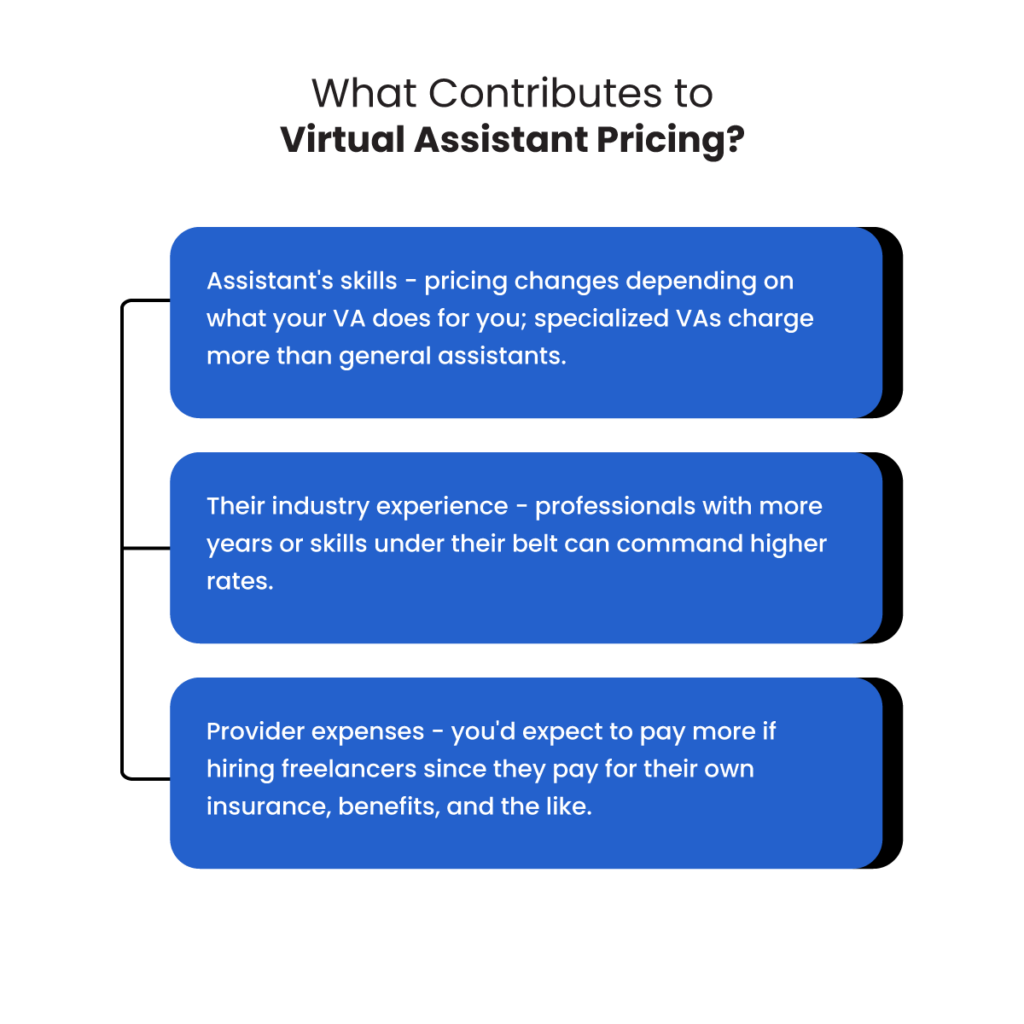The business process outsourcing industry has enjoyed a steady growth in the past few years. According to Statista, the global market size of the outsourced services industry is valued at 92.5 billion USD. There are so many great options for SMBs who want to hire a remote assistant. If you’re considering getting one, you probably want to know where your money is going. It’s important to understand the pros and cons of the various virtual assistant pricing structures on the market today.
Wing provides unlimited VA services Monday to Friday for 8 or 4 hour blocks, depending on your plan. All Wing clients pay a flat monthly fee that grant access to managed remote assistants. Higher-tier packages provide unlimited workflows, multiple user accounts, and multiple assistants.
Many considerations go into virtual assistant pricing. Hopefully, reading this article convinces you that Wing is the most cost efficient option for your business. Let’s dive in!

1. What considerations go into virtual assistant pricing
The fee structure is one of the first considerations of an employer. Whether you end up working with a managed VA solution or a solo practitioner, you must consider the fee structure. What, exactly, are the factors contributing to VA pricing?
Here are the considerations we’ll be diving into:
- Skills
- Experience
- Expenses
Let’s dive into these one by one.
The assistant’s skills
You might be looking for an administrative virtual assistant or an executive assistant, depending on your business needs. Virtual assistant pricing also changes depending on what your VA does for you. EAs or executive assistants, for instance, have a different role than administrative assistants. When it comes to the differences between AAs and EAs, think of the difference between task managers and project managers.
Administrative assistants are in the trenches handling data entry, simple graphic design, sending and receiving messages, and more. All of this is incredibly valuable work and might be just what your organization needs.
On the other hand, executive assistant VAs are typically more proactive than their administrative assistant counterparts. A good EA can optimize calendars, streamline workflows, make travel bookings, plan events and arrange appointments. (Not to toot our own horn, but we cover this conversation a lot more in depth! Check out our blog post, Executive Assistant vs. Administrative Assistant: Which to Hire?)
Here’s a list of skills both EAs and AAs should have:
- Time management
- Communication
- Research
- Problem-solving
- Empathy
- Adaptability
Besides having management skills like research and problem solving, EAs and AAs also need skill specialization. Wing has VAs that specialize in a variety of industry-specific skills, including:
- E-commerce
- Real estate
- Content marketing
- Graphic design
- Sales
If you hire other services, you would spend time onboarding a generalist in these areas. With Wing, you can choose specialized VAs and he or she can contribute on day one. These specialized skills may cost more, but with Wing, they are rolled into the regular subscription rate.
Their industry experience
It’s important to note that when a VA quotes you a rate, it is not set in stone. Rates often increase yearly. As assistants gain more experience, they will need more compensation. Also, starting rates will naturally be higher for remote assistants with more experience.
Professionals usually quantify ‘experience’ as the number of years working in the industry. VAs with high profile clients on their resumes and quality references could also charge more.
The company’s expenses
Pricing also varies based on what the provider shoulders. For instance, if you hire a freelancer, you’d expect to pay more since they don’t have an employer absorbing the costs of healthcare, retirement fund contributions, and the like.
You’ll want to make sure that whatever VA service you go with is looking out for your bottom line too. That means working as efficiently as possible and saving time without sacrificing results. One surefire way to do that is to lean on technology.
While Wing virtual assistants are 100% human. Our teams are supported by AI tools that enhance the speed and quality of their results. Using AI behind the scenes allows Wing to provide high quality assistance at more affordable prices than any other comparable VA company.
But if you’d like to have a more detailed look at the pros and cons of hourly, project/task-based, package-based, or period-based pricing, Don’t worry. We’re going into detail about these pricing structures in the next part.
2. Virtual assistant pricing: by the hour
It’s pretty clear what paying for VA services by the hour means. This method implies that the virtual assistant will cover the costs an employee doesn’t, like health insurance and retirement contributions. For this reason, hourly rates are typically higher than the corresponding costs for package rates.
Of course, just because this will cost you more on average than other pricing structures doesn’t mean it’s bad for your business. There are many pros to hourly service pricing, like flexibility and focus, which we’ll discuss now.
Pros of hourly service pricing
Hourly pricing is popular for solo VA practitioners who balance many different clients. This can be good for the client as it is clear that the VA is only charging for the hours he or she is explicitly working.
Your business may need a specific task completed, for instance data entry. You might not need any of the other services a VA could potentially oversee, like calendar management, reception duties, and social media marketing.
In this case, an hourly rate would be a perfect fit, because you know exactly what you need and (hopefully) how long it should take. This can help your business budget for the investment of bringing a VA on board. Whenever you’re done, you can simply terminate your relationship with the VA and move on. This might be worth the extra cost of hourly fees, but for others the cost may be a major con.
Cons of hourly service pricing
One of the main cons of hourly service pricing for VAs is that it can be more costly than a package deal, depending on how quickly it takes to complete tasks. Also, if you want to streamline your business and make workflows more efficient, the hourly VA doesn’t exactly have an incentive to do this, as it means less business for her.
Hourly implies paying as you go, which can add up if you’re not careful. However, you can use this method to quantify the deliverable at first. Once you’re familiar with how long a task takes to complete, you could shift to a package-based pricing structure, which we cover next in this article.
3. Virtual assistant pricing: by the package
Pricing by the package for virtual assistant services typically entails paying for a block of hours up front, every month. The main advantage with this pricing structure is convenience, while one disadvantage that managers report is that it can lead to excessive fees. Let’s dig a little deeper on both.
Pros of package pricing
Package pricing avoids the hassle of keeping track of hours. The employer and VA decide ahead of time how many hours per month your virtual assistant will be on call and what tasks they’ll complete.
Rather than deal with the hassle of keeping track of hours and paying a premium for hourly rates, Wing offers pricing that covers periods of time. This is a little more streamlined than the hourly approach or pricing by bundling services. But
Cons of package pricing
Depending on your business needs, this method of virtual assistant pricing can lead to excessive fees for time you don’t need. If your business only needs a VA for intermittent small projects, you run the risk of taking on someone who will not always be helpful.
4. Virtual assistant pricing: per period basis
Another way of deciding on virtual assistant pricing is by paying a provider as you would a retainer, on a per period basis. How you define a specific time period is up to you, as it’s basically arbitrary. You could agree to pay by the month, quarterly, or even a yearly rate if that’s what works in your situation.
Pros of per period pricing
Wing packages charge a monthly or quarterly rate that includes a customer success manager and a dedicated, entirely managed remote assistant with a 3 minute response time. Wing VAs are available via phone, text, mobile app, web app, Slack, or just about anywhere else your business might communicate.
Cons of per period pricing
Per period pricing can have its downsides. In some cases a subscription to a managed VA service may mean that you’re paying for services and time you don’t need. It also means you are committing to one particular business and way of doing things, which may not be beneficial for fast-moving startups that are pivoting frequently and may have different needs from month to month.
5. Virtual assistant pricing: per project or task
Just like the hourly fee structure we discussed earlier, per project pricing is self explanatory. One of the major benefits to this way of doing business is it allows you the flexibility to end the relationship with your VA if things are working out. One of the drawbacks is that it has the potential to lead to frequent turnover and can potentially sap your bandwidth.
Pros of per task/project pricing
Task/project pricing can be a great way to get a feel for a VA’s services. Rather than blindly signing up for a long term commitment, you can get a short term sense of whether this VA arrangement is a good fit for your business. The hourly method penalizes you if a VA takes a long time to complete a task. With the task-based payment approach, you’re paying for the completed task, no matter how long it takes your VA
The project-based pricing structure is very helpful for the VA too in many instances. Regardless of a VA’s experience level, there will be tasks which he or she is unfamiliar with. Charging by the task or project gives your new virtual assistant time to learn the ins and outs of your business and how long tasks take.
Cons of per task/project pricing
Managers who elect to pay for VA services on a per task or per project basis can end up creating more work for themselves due to frequent turnover.
It takes a lot of time to onboard and train a new VA, which adds up to costs. A long term relationship with a VA paid on a per period basis means you’ll be working with someone who will get to know your business. A dedicated, managed VA learns how to handle a wide variety of tasks for companies in many different industries. If you elect to pay for VA services per project, you may end up needing to find multiple VAs for multiple projects, or need to onboard a new VA every time you have a new project. This can lead to headaches in the long run.
So far we’ve looked at hourly, package, time period, and per task/project pricing. What’s the best VA pricing structure for your business?
6. Which is the best virtual assistant pricing structure?
The per time period (otherwise known as subscription) payment structure is hands down the best approach and wins in overall efficiency and ease of use. If your business can afford a regular subscription to a managed VA service, it’s worth the cost. Here’s why.
With a dedicated, managed VA on board, you won’t need to spend time training and retraining due to high turnover rates. You will have a set array of tasks that you can expect them to fulfill, and you won’t need to track how long it takes them to deliver results.
Wing VAs work with an easy to use task queue. Simply drag and drop the tasks you want to add to your Wing VA’s queue and you can be confident they’ll deliver results. Wing can also help you visual and streamline workflows with an easy to use software tool included in your package. And if you’re too busy to organize a workflow, your VA can do it for you.
All this adds up to a great value for your money. A Wing VA handling inbox and calendar management, ingoing and outgoing calls, and specialized tasks like small scale graphic design and content marketing. You’ll be saving time and giving your team more bandwidth to handle the mission critical work you hired them for.
Wing provides quality VA services at a fair price
Wing provides dependable, high quality VA services at a price that is competitive. When you consider all the added perks included in the cost of a Wing subscription, from management and training to specialization and availability, you can understand why it’s a fair take on virtual assistant pricing.
Schedule a call to discuss your business needs today.
Dan Eder writes frequently about digital marketing trends, SaaS, and e-commerce. He has previously worked as a content writer at an SEO agency for tech companies, an e-commerce specialist at a Fortune 500 company, and a journalist for several educational outlets. Read more from him at www.daneder.com.







